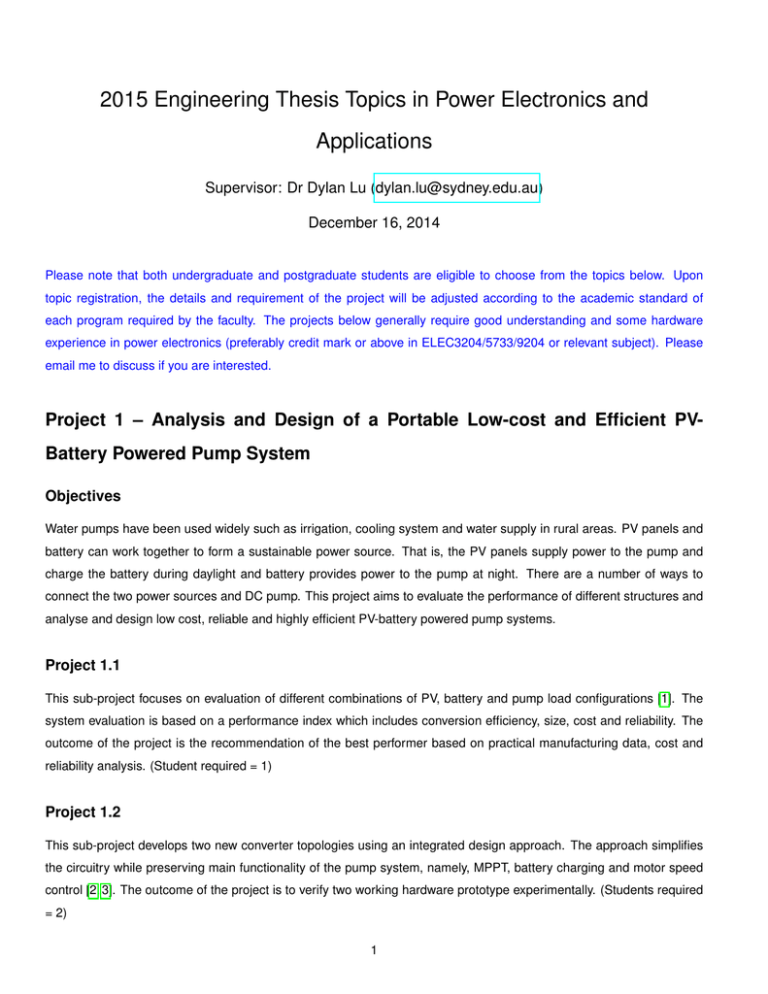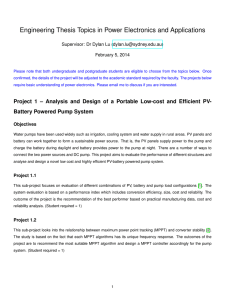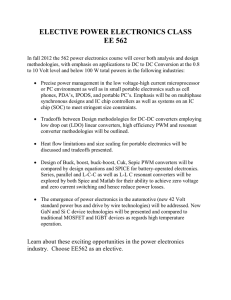2015 Engineering Thesis Topics in Power Electronics and
advertisement

2015 Engineering Thesis Topics in Power Electronics and Applications Supervisor: Dr Dylan Lu (dylan.lu@sydney.edu.au) December 16, 2014 Please note that both undergraduate and postgraduate students are eligible to choose from the topics below. Upon topic registration, the details and requirement of the project will be adjusted according to the academic standard of each program required by the faculty. The projects below generally require good understanding and some hardware experience in power electronics (preferably credit mark or above in ELEC3204/5733/9204 or relevant subject). Please email me to discuss if you are interested. Project 1 – Analysis and Design of a Portable Low-cost and Efficient PVBattery Powered Pump System Objectives Water pumps have been used widely such as irrigation, cooling system and water supply in rural areas. PV panels and battery can work together to form a sustainable power source. That is, the PV panels supply power to the pump and charge the battery during daylight and battery provides power to the pump at night. There are a number of ways to connect the two power sources and DC pump. This project aims to evaluate the performance of different structures and analyse and design low cost, reliable and highly efficient PV-battery powered pump systems. Project 1.1 This sub-project focuses on evaluation of different combinations of PV, battery and pump load configurations [1]. The system evaluation is based on a performance index which includes conversion efficiency, size, cost and reliability. The outcome of the project is the recommendation of the best performer based on practical manufacturing data, cost and reliability analysis. (Student required = 1) Project 1.2 This sub-project develops two new converter topologies using an integrated design approach. The approach simplifies the circuitry while preserving main functionality of the pump system, namely, MPPT, battery charging and motor speed control [2, 3]. The outcome of the project is to verify two working hardware prototype experimentally. (Students required = 2) 1 Project 1.3 This sub-project investigates the faults detection, protection and fault-tolerant operation of the PV-battery powered pump system. The study will focus on a number of representative configurations to analyse the possible faults occurrence and develop relevant protective measures [4–7]. (Student required = 2) Project 1.4 This sub-project investigates the PV system performance when it is subjected to non-uniform environmental conditions. In particular, the partial shading effect on MPPT performance [8]. In addition, the project develops multiple-PV panels or strings using reduced number of sensors [9]. The outcome of this project is to develop an improved algorithm to keep track of the global maximum power point with multiple PV panels/strings. (Student required = 2) Project nature: Micro-controller programming, mathematical modeling and analysis, control theory, and design, practical implementation and testing of power converters. Presumed knowledge and skills: Power electronics, electronic devices, circuit theory and design, mathematical analysis (MATLAB), micro-controller programming such as PIC and Arduino, and hardware skills. Project 2 – Modelling and Analysis of a Digital Controller for DC/DC Power Converters Objective Analog PWM controllers have been widely adopted in switch-mode power supplies. However digital control offers several advantages such as lower component count, more complicated control schemes including protection and adaptive control, and better interfacing with both analog and digital onboard circuits [10, 11]. This project focuses on the foundamental understanding of digital controlled PWM dc/dc converters using low-cost microcontroller or digital signal processor (DSP) [12]. The outcomes of the project are to model a commercially available microcontroller/DSP and to control a basic dc/dc converter. Simulation and experiments will be carried out to verify the analysis. This project is co-supervised by Dr. Yash Shrivastava (yash.shrivastava@sydney.edu.au. (Student required = 1) Project nature: Micro-controller programming, mathematical modeling and analysis, control theory, and design, practical implementation and testing of power converters. 2 Presumed knowledge and skills: Power electronics, electronic devices, circuit theory and design, mathematical analysis (MATLAB), micro-controller programming such as PIC and Arduino, and hardware skills. Project 3 – Grid-connected PV System with Energy Storage Objective Although there are hundreds of thousands of PV inverters installed and running, many of them are not operating in optimal conditions. There are quite many issues with connecting PV inverters to the grid. For example, when the PV inverter concentration in one region is very high, it is most likely the voltage profile in that region will rise too high during full sun condition, causing the PV inverters to shut down as a protective measure. In such case the PV system is losing power when it was supposed to capture and convert the maximum solar energy to electricity. The objectives are as follows: 1. Improve the communication between MPPT controller and inverter controller. 2. Add appropriate de-tuning function to MPPT algorithm to prevent voltage overshoot during full sun condition 3. Add plug-and-run solar power device to existing PV system to absorb excessive solar energy if necessary This project is co-supervised by Dr. Keith Mitchell (komitch@bigpond.com. Project 3.1 This sub-project is to design an inverter circuit working in grid-connected mode and a micro-controller for regulation of output voltage and input voltage. The project also requires to develop communication capability among the three power conversions using PLC or wireless communications. (Student required = 1) Project 3.2 This sub-project is to design a dc/dc converter as MPPT and develop a MPPT controller which performs de-tuning function during oversupply condition. The project also requires to develop communication capability among the three power conversions using PLC or wireless communications. (Student required = 1) Project 3.3 This sub-project is to design a bi-directional dc/dc converter and controller for battery storage system. The project also requires to develop communication capability among the three power conversions using PLC or wireless communications. (Student required = 1) 3 Project nature: Micro-controller programming, mathematical modeling and analysis, control theory, and design, practical implementation and testing of power converters. Presumed knowledge and skills: Power electronics, electronic devices, circuit theory and design, mathematical analysis (MATLAB), micro-controller programming such as PIC and Arduino, PLC or wireless communications and hardware skills. Project 4 – AC Adaptor Re-purposing Objective With the growing usage of electronics gadgets and small electrical appliances, the number of ac adaptors has also increased. However, once the electronics products and electrical appliances are not being used due to failure or outdated, the associated ac power adaptors often become useless. Simply disposal of those adaptors will dump more e-waste and pollute the environment. This projects looks into recycling these unused adaptors and turning them into more powerful adaptors for other electrical appliances or systems [13]. Project 4.1 This sub-project is to design a multiple-input dc/dc power electronics interface to connect a number of ac adaptors with similar ratings (e.g. smartphone adaptors) to power higher power load, e.g. a laptop computer. (Student required = 1) Project 4.2 This sub-project is to design a multiple-input dc/dc power electronics interface to connect a number of ac adaptors with different ratings (e.g. 12V/1A, 5V/2A, etc.) to power higher power load, e.g. a laptop computer. (Student required = 1) Project 4.3 This sub-project is to design a power electronics interface to facilitate hot-swapping of power supply modules [14]. (Student required = 1) Project nature: Micro-controller programming, electric circuit design, and design, practical implementation and testing of power converters. Presumed knowledge and skills: Power electronics, electronic devices, circuit theory and design, mathematical analysis (MATLAB), micro-controller programming such as PIC and Arduino, and hardware skills. 4 References [1] I. Aharon and A. Kuperman, “Topological overview of powertrains for battery-powered vehicles with range extenders,” IEEE Transactions on Power Electronics, vol. 26, no. 3, pp. 868–876, March 2011. [2] L. An and D. D.-C. Lu, “Design of a single-switch dc-dc converter for pv-battery powered pump system,” in 2013 1st International Future Energy Electronics Conference (IFEEC), Nov 2013, pp. 359–364. [3] L. An and D. Lu, “Design of a Single-Switch DC/DC Converter for a PV-Battery Powered Pump System with PFM+PWM Control,” IEEE Transactions on Industrial Electronics, vol. PP, no. 99, pp. 1–1, 2014. [4] H. Beltran, E. Perez, Z. Chen, F. Gimeno-Sales, S. Segui-Chilet, J. Soler, and E. Daroqui, “Analog fixed maximum power point control for a pwm step-down converter for water pumping installations,” in Proceedings, 13th European Conference on Power Electronics and Applications (EPE ’09), Sept 2009, pp. 1–10. [5] E. Ribeiro, A. Cardoso, and C. Boccaletti, “Fault-tolerant strategy for a photovoltaic dc–dc converter,” IEEE Transactions on Power Electronics, vol. 28, no. 6, pp. 3008–3018, June 2013. [6] D. Dah-Chuan Lu, J. L. Soon, and D. Verstraete, “Two-transistor step-down dc/dc converters with fault-tolerant capability,” in 2014 Australasian Universities Power Engineering Conference (AUPEC), Sept 2014, pp. 1–5. [7] E. Jamshidpour, P. Poure, E. Gholipour, and S. Saadate, “Single switch dc-dc converter with fault-tolerant capability under open and short circuit switch failures,” IEEE Transactions on Power Electronics, vol. PP, no. 99, pp. 1–1, 2014. [8] S. Lyden, M. Haque, A. Gargoom, and M. Negnevitsky, “Review of maximum power point tracking approaches suitable for pv systems under partial shading conditions,” in Proceedings, 2013 Australasian Universities Power Engineering Conference (AUPEC), Sept 2013, pp. 1–6. [9] M. Seyedmahmoudian, A. T. Oo, V. Arangarajan, G. M. Shafiullah, and A. Stojcevski, “Low cost mppt controller for a photovoltaic-based microgrid,” in 2014 Australasian Universities Power Engineering Conference (AUPEC), Sept 2014, pp. 1–6. [10] D. Maksimovic, R. Zane, and R. Erickson, “Impact of digital control in power electronics,” in The 16th International Symposium on Power Semiconductor Devices and ICs, 2004. Proceedings. ISPSD ’04., May 2004, pp. 13–22. [11] C. Buccella, C. Cecati, and H. Latafat, “Digital control of power converters – a survey,” Industrial Informatics, IEEE Transactions on, vol. 8, no. 3, pp. 437–447, Aug 2012. [12] D. Maksimovic and R. Zane, “Small-signal discrete-time modeling of digitally controlled pwm converters,” IEEE Transactions on Power Electronics, vol. 22, no. 6, pp. 2552–2556, Nov 2007. [13] D. Rogers, J. Green, M. Foster, D. Stone, D. Schofield, S. Abuzed, and A. Buckley, “Repurposing of atx computer power supplies for pv applications in developing countries,” in 2013 International Conference on Renewable Energy Research and Applications (ICRERA), Oct 2013, pp. 973–978. [14] Y. Chen, D.-W. Cheng, and Y.-S. Lee, “A hot-swap solution for paralleled power modules by using current-sharing interface circuits,” IEEE Transactions on Power Electronics, vol. 21, no. 6, pp. 1564–1571, Nov 2006. 5





